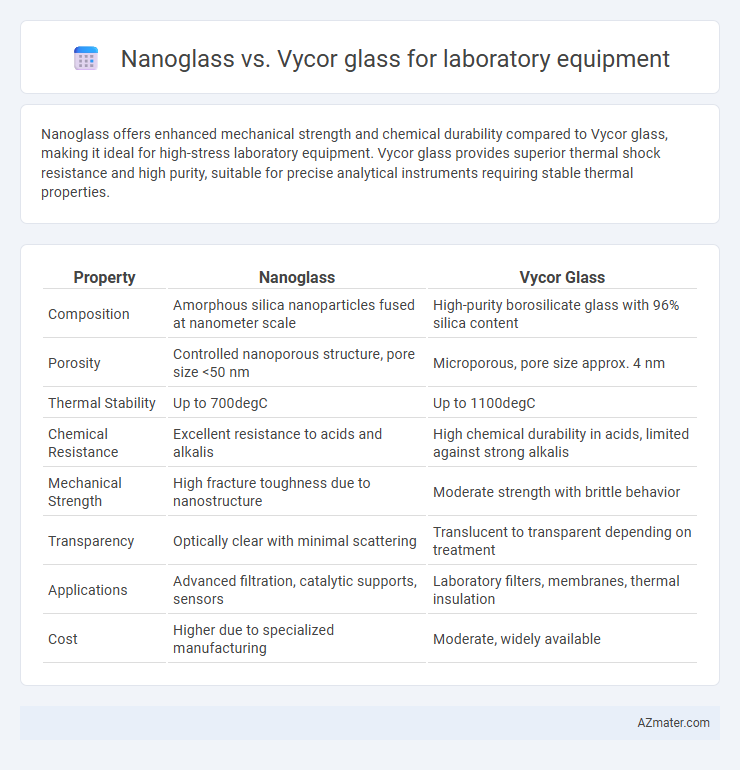Nanoglass offers enhanced mechanical strength and chemical durability compared to Vycor glass, making it ideal for high-stress laboratory equipment. Vycor glass provides superior thermal shock resistance and high purity, suitable for precise analytical instruments requiring stable thermal properties.
Table of Comparison
| Property | Nanoglass | Vycor Glass |
|---|---|---|
| Composition | Amorphous silica nanoparticles fused at nanometer scale | High-purity borosilicate glass with 96% silica content |
| Porosity | Controlled nanoporous structure, pore size <50 nm | Microporous, pore size approx. 4 nm |
| Thermal Stability | Up to 700degC | Up to 1100degC |
| Chemical Resistance | Excellent resistance to acids and alkalis | High chemical durability in acids, limited against strong alkalis |
| Mechanical Strength | High fracture toughness due to nanostructure | Moderate strength with brittle behavior |
| Transparency | Optically clear with minimal scattering | Translucent to transparent depending on treatment |
| Applications | Advanced filtration, catalytic supports, sensors | Laboratory filters, membranes, thermal insulation |
| Cost | Higher due to specialized manufacturing | Moderate, widely available |
Introduction to Nanoglass and Vycor Glass
Nanoglass exhibits a unique nanostructured amorphous phase, enhancing mechanical strength and chemical durability, making it suitable for advanced laboratory equipment requiring high precision and resistance. Vycor glass, a high-silica porous glass with a 96% SiO2 composition, offers exceptional thermal stability, low thermal expansion, and chemical resistance, ideal for demanding laboratory environments. The distinct structural properties of Nanoglass and Vycor directly influence their performance in laboratory settings, with Nanoglass emphasizing strength and Vycor focusing on thermal and chemical resilience.
Chemical Composition Comparison
Nanoglass features an amorphous silica-based composition with nanoscale porosity, enhancing chemical resistance and thermal stability, whereas Vycor glass is primarily composed of high-purity silica with about 96% SiO2 content and a controlled pore structure that improves durability and resistance to alkalis. The chemical inertness of Nanoglass makes it highly suitable for handling aggressive solvents and acids, while Vycor's slightly porous network allows for effective filtration and thermal shock resistance in standard lab applications. Both materials exhibit excellent resistance to chemical corrosion, but Nanoglass provides superior performance in environments requiring nanoscale structural stability and enhanced surface interactions.
Physical Properties and Strength
Nanoglass exhibits superior mechanical strength with a higher fracture toughness and enhanced durability compared to Vycor glass, making it ideal for demanding laboratory environments. Vycor glass offers excellent thermal stability and low thermal expansion, but its brittleness limits its resistance to mechanical stress. The higher density and nano-structured composition of Nanoglass contribute to its improved physical properties, providing greater resistance to cracking and deformation under pressure.
Thermal Resistance and Stability
Nanoglass offers superior thermal resistance withstanding temperatures up to 700degC, making it ideal for high-heat laboratory applications. Vycor glass exhibits excellent thermal stability, maintaining structural integrity and chemical resistance up to 500degC. The enhanced thermal properties of Nanoglass provide greater durability in extreme laboratory conditions compared to Vycor glass.
Chemical Resistance and Reactivity
Nanoglass exhibits superior chemical resistance compared to Vycor glass, making it less prone to corrosion and degradation when exposed to strong acids and bases in laboratory settings. Vycor glass, while highly resistant to thermal shock and mechanical stress, can show increased reactivity with hydrofluoric acid and certain alkaline solutions. For applications demanding minimal chemical interaction and maximum durability against aggressive reagents, Nanoglass provides enhanced performance and longevity in laboratory equipment.
Transparency and Optical Clarity
Nanoglass exhibits superior optical clarity and higher transparency compared to Vycor glass, making it ideal for precision laboratory equipment requiring clear visual observation. The nanoscale structure of Nanoglass minimizes light scattering, ensuring high transmission rates across the visible spectrum. Vycor glass, while chemically resistant and durable, has increased light diffusion due to its porous microstructure, reducing optical clarity in applications demanding high transparency.
Price and Availability in the Market
Nanoglass offers advanced chemical resistance and durability but generally comes at a higher price point due to sophisticated manufacturing processes and limited widespread production. Vycor glass, known for its porous structure and thermal stability, is more readily available and cost-effective, making it a preferred choice for budget-conscious laboratories. Market availability favors Vycor glass because it is produced by multiple suppliers in larger quantities, ensuring easier procurement and lower lead times compared to Nanoglass.
Typical Laboratory Applications
Nanoglass offers superior chemical resistance and thermal stability, making it ideal for high-precision laboratory applications such as microfluidics and advanced spectroscopy. Vycor glass excels in filtration and sample containment due to its high porosity and durability, commonly used in gas analysis and catalyst support systems. Both materials provide excellent performance in laboratory settings, but Nanoglass is preferred for cutting-edge research requiring ultra-pure conditions.
Advantages and Limitations of Nanoglass
Nanoglass offers superior surface area and enhanced chemical stability compared to Vycor glass, making it ideal for sensitive laboratory applications requiring high precision. Its nanoscale pore structure improves filtration efficiency but may pose challenges in mechanical strength and durability under extreme conditions. While Vycor glass provides robust thermal resistance and chemical inertness, Nanoglass's advantages include better adsorption capacity and tailored pore size distribution for specialized experimental setups.
Advantages and Limitations of Vycor Glass
Vycor glass offers exceptional chemical durability and thermal resistance, making it ideal for high-temperature laboratory applications and aggressive chemical environments. Its porous structure provides excellent thermal shock resistance, but this same porosity can lead to moisture absorption, potentially compromising material integrity over time. Compared to Nanoglass, Vycor glass is less transparent and more prone to mechanical brittleness, limiting its use in precise optical instruments.

Infographic: Nanoglass vs Vycor glass for Laboratory equipment
 azmater.com
azmater.com